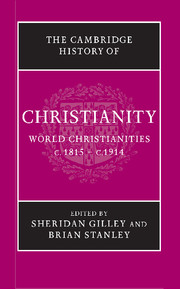Book contents
- Frontmatter
- 1 Introduction
- PART I CHRISTIANITY AND MODERNITY
- PART II THE CHURCHES AND NATIONAL IDENTITIES
- PART III THE EXPANSION OF CHRISTIANITY
- 26 African-American Christianity
- 27 Christian missions, antislavery and the claims of humanity, c.1813–1873
- 28 The Middle East: western missions and the Eastern churches, Islam and Judaism
- 29 Christians and religious traditions in the Indian empire
- 30 Christianity in East Asia: China, Korea and Japan
- 31 Christianity in Indochina
- 32 Christianity as church and story and the birth of the Filipino nation in the nineteenth century
- 33 Christianity in Australasia and the Pacific
- 34 Missions and empire, c.1873–1914
- 35 Ethiopianism and the roots of modern African Christianity
- 36 The outlook for Christianity in 1914
- Select General Bibliography
- Chapter Bibliography
- Index
- References
33 - Christianity in Australasia and the Pacific
from PART III - THE EXPANSION OF CHRISTIANITY
Published online by Cambridge University Press: 28 March 2008
- Frontmatter
- 1 Introduction
- PART I CHRISTIANITY AND MODERNITY
- PART II THE CHURCHES AND NATIONAL IDENTITIES
- PART III THE EXPANSION OF CHRISTIANITY
- 26 African-American Christianity
- 27 Christian missions, antislavery and the claims of humanity, c.1813–1873
- 28 The Middle East: western missions and the Eastern churches, Islam and Judaism
- 29 Christians and religious traditions in the Indian empire
- 30 Christianity in East Asia: China, Korea and Japan
- 31 Christianity in Indochina
- 32 Christianity as church and story and the birth of the Filipino nation in the nineteenth century
- 33 Christianity in Australasia and the Pacific
- 34 Missions and empire, c.1873–1914
- 35 Ethiopianism and the roots of modern African Christianity
- 36 The outlook for Christianity in 1914
- Select General Bibliography
- Chapter Bibliography
- Index
- References
Summary
Christianity in Australia
Origins and foundations
Christianity came to Australia with the settlement of Sydney Cove in 1788, before the French Revolution and the formation of the major British evangelical missionary societies. In Australia, in contrast to the rest of the Pacific, it came as a chaplaincy to soldiers and convicts rather than as a mission to the indigenous people. From its origins in Australia, then, Christianity has been seen as part of the apparatus of law and order. The transformation of a convict society into a nation of the healthy and law-abiding may be understood as one of Christianity’s major achievements in the nineteenth century. Australians may have had difficulty in resisting materialism and secularism, but there was no doubt in anybody’s mind that, in the nineteenth century, Australia was a Christian country. The great majority of the settler population identified with a Christian denomination, either really or nominally. Christianity was a major factor in shaping the Australian colonies.
A new denominational mix
Although the Church of England had the largest percentage adherence of any denomination in Australia until 1986 when it was overtaken by the Catholics, membership of other denominations was greater as a percentage of the population than in England, in itself creating a different religious culture. Non-conformists, especially Congregationalists and Calvinistic Methodists, were revered early settlers in New South Wales to which they came en route to, or after displacement from, the Pacific islands to which they were sent by the London Missionary Society (LMS).
- Type
- Chapter
- Information
- The Cambridge History of Christianity , pp. 542 - 559Publisher: Cambridge University PressPrint publication year: 2005

